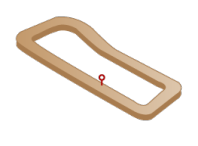Race type - Jump
Plumpton
Course details

GUIDE - For Racecourse
Left-handed, flattened oval circuit of about 1m2f
Plumpton is situated on the picturesque South Downs in the heart of Sussex and is one of Britain's leading small jumps courses, staging around 16 meetings a year between September and May. The historians amongst us will be interested to know it started life as a centre for hare coursing in the early 19th century and this pursuit continued right up to 1908. However, the Victorians loved their horse racing too and the construction of a rail line from London to nearby Lewes encouraged local entrepreneurs to build a purpose built course on the site, with the first recognised meeting taking place here in 1884. Apart from being closed for both the 20th century wars, Plumpton has continued to draw in the crowds and while the standard of racing is generally low, the bigger yards have been know to run some of their better horses here in search of easier pickings.
Principal Races
Nearly every track stages a 'National' of sorts and Plumpton is no exception with the running of the Sussex National over a distance of 3m5f every January. This is by far the track's most valuable contest with connections of the 2012 winner Double Dizzy picking up nearly £10k. A nice innovation in recent years has been the introduction of a £25k bonus payable to the owner of any horse that wins a novice chase or a beginners' chase at the track which then goes on to win any chase at the Cheltenham Festival. This encourages the bigger stables to run their better novices here and the prize money for such contests is well above the standard.

Course Characteristics
The course is a tight left-hander with some severe undulations throughout. The most noticeable of these is a steeply downhill section down the back straight and that makes the fence that is located there extremely tricky to negotiate. Overall, though, the fences aren't too difficult and it's not a bad place to introduce a novice, providing they are not of the galloping type. Given the undulations and tight turns, it generally pays to be up with the pace throughout as it can be difficult to make up ground, especially in bigger fields when jockeys can find themselves trapped in mid-field. Horses can make all if good enough and providing their jockey hasn't gone off too fast, which is even more important when the ground is riding testing, as it frequently is.
Top Trainers
Gary Moore trains nearby on the Downs and he loves to have a winner here. In the past five seasons, 35 of his horses have passed the post in front and the majority of these were ridden by his son Jamie, making them a combination to follow. His strike rate of 17% tells you he trains plenty of losers too but by concentrating on those horses that are clearly fancied, as opposed to the no-hopers, you will likely turn a profit. You would have made a profit backing all of Alan King's runners at the track (£16 to level stakes) and his five-year strike rate is an impressive 37% (nearer 50% in the 2011/12 season). Seamus Mullins does well with his small string here, sending out 17 winners at a strike rate of 13%, as does Nick Gifford (15 winners / 20%). Welsh wizards Evan Williams and Tim Vaughan rarely leave the track empty handed.
Top Jockeys
With his father providing plenty of ammunition, Jamie Moore leads the way numerically with 23 winners since 2007, albeit at a modest strike rate of 15%. This is bettered by both Richard Johnson and Noel Fehily (20% and 28% respectively), and the latter is proving particularly profitable to follow with all his rides yielding a level stakes profit of £33. Alan King's stable jockey Robert Thornton is also turning a small level stakes profit with 17 of his 57 rides (30%) being led into the winner's enclosure. More recently, it's been the turn of the stable No.2 Wayne Hutchinson to shine with a strike rate in the region of 40%.